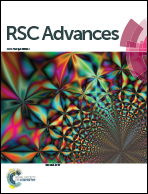Catechin assisted phase and shape selection for luminescent LaVO4 zircon†
Abstract
Potential applications of rare earth orthovanadates are increasing day-by-day owing to the possibilities of tuning the optical properties through a host of facile modifications. This has brought about the need to look at orthovanadates beyond those of Y, Gd and Lu. Amongst the possibilities, synthesis of LaVO4, with or without doping in its metastable zircon phase against the monoclinic phase which is a poor phosphor candidate has been challenging. With applications spreading to the areas of biology and medicine, a need to replace the conventional EDTA as a ligand strategy has been indicated by researchers in this area. Optimization of luminescent properties of t-LaVO4 for a range of applications would require fair control over not just the phase but also the size and shape as well. In this work, we report the use of catechin – a natural polyphenol as a structure director, wherein through modulation of the RE to catechin ratio, the phase as well as shape is controllable. The enhancement of luminescence upon doping with Eu3+ and Sm3+ is also found, indicating that the optical properties of these phosphors are strongly dependent on the morphology. The rod-like structure exhibited the strongest red emission with highest intensity. This procedure is simple and promises to provide a pathway for varying morphology into other lanthanide orthovanadates.


 Please wait while we load your content...
Please wait while we load your content...